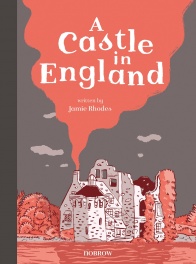“A Castle in England” provides a rich backdrop for five historical tales in this unique collection published by Nobrow Press.

Written by Jamie Rhodes
Illustrated by VariousA collaboration between writer Jamie Rhodes and the National Trust, this unique graphic novel plunges us into the rich and often dark history of Scotney Castle in Kent.
Recreating the castle’s past from the Medieval to the Edwardian ages, five rising stars from the UK comics scene (Isaac Lenkiewicz, Briony May Smith, William Exley, Becky Palmer and Isabel Greenberg) have illustrated five short stories that mix fiction with fact, creating a visually striking graphic collection that is steeped in historical context.
Conceptually speaking, “A Castle in England” is ambitious. It aims to cover a broad swath of one castle’s history, zeroing in on five of its most interesting historical moments. For additional detail, family trees are reproduced at the beginning of each tale; there’s also an introductory note for each story, and notes afterward to fill in the blanks further.
The book itself is a gorgeous object, with sketchy, orange-tinted interiors that just beg you to leaf through. The artist’s styles are not magnitudes away from each other, lending the book of feeling of unity even as you jump from time period to time period.
“The Labourer”, with art by Isaac Lenkiewicz, centres on the Peasant’s Revolt of 1381, and begins the book on a bloody note. With delicate lines, deep charcoal shadows, and cartoony, expressive figures, the tale has a crisp, inviting look even as heads roll. The compositions are careful and precise, revealing just enough background detail to keep the circumstances legible.
Briony May Smith’s work in “The Priest” is murkier and more ornate, suiting the political ambiguity of the English Reformation beautifully. With smudgey strokes of charcoal delineating dimly-lit rooms, and pale, minimal faces peering out of the darkness, the mood is appropriately heavy. The only off note is the hand-lettering, which can take a moment to decipher, particularly with fun words like “recusancy”.
“The Smuggler” tells of (you guessed it) smuggling in the early 18th century, and William Exley’s work puts the spotlight on grim jawlines, dashing poses, and sweeps of landscape. The figures are full of swagger, which fits the high stakes of the plot well. But, like all of the stories, there’s a high number of panels per page, and with the wealth of background detail and minimal white space between panels, it can be especially hard to follow the action.
Becky Palmer’s work in “The Widow” is watery and austere, with a touch of storybook charm, as some pretty grim events unfold. Inky washes lend texture and interest, and the layouts are lucid and versatile. Most importantly, the details of the Victorian mansion – its garden, the wallpaper, an ornate entryway – come across with striking clarity, giving the tale the strongest sense of place in the collection.
“The Hunter”, an Edwardian tale with art by Isabel Greenberg, is an standout, with the most legible plot and concise, expressive art. Thick lines delineate jagged, grotesque faces, and the exotic locales flow and warp, threatening to break free of the page. Splash pages depicting the life cycle of a mosquito move things to the realm of the psychedelic, and all the while, Greenberg’s unique hand-lettering lends a touch of levity.
While the art is strong overall, there are writing-based narrative issues with each of the stories that make them difficult to immerse yourself in. Rapidly moving plots, large casts of characters, and complex historical circumstances are not easily to captured in the space of a few pages, and often the stories require rereads in order to be grasped (and even then incompletely). With a wealth of materials to draw on – writer Jamie Rhodes actually lived at Scotney Castle while consulting with its historians – it seems like the castle itself has so much to say that the five stories crack under the pressure.
This is where the additional materials would seem to offer help – but weirdly, the introductions before each story tend to summarize the notes that come after the story, so if you read both, you encounter some repetition, rather than a wealth of information. The family trees also feel like one note too many, particularly in those instances where none of the family members figure in the story.
Reality-based comics are not easy to do – it’s one of the reasons I find them fascinating. It’s difficult to condense information in a way that does justice to the subject, balancing accuracy and excitement; it’s difficult not to resort to paragraphs of text to give additional context; and above all, it’s difficult to pick out exactly which elements of a narrative would translate best visually. All of these challenges are evident in “A Castle in England”, a collection which becomes notable for its ambition more than its execution.
Still, it’s a beautiful book, and if you’re a fan of any of the artists (heck yeah Isabel Greenberg), it’s well worth a browse.






